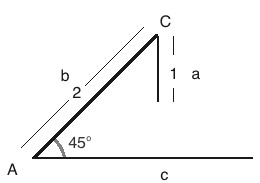Guest, it is not true that we can always form a triangle given 2 sides and a non-included angle.
For example, let a = 1, b = 2, A = 45°

The length of side c is not fixed and the measure of angle C is not fixed.
There is still no way to exend/shorten c or rotate a so that a touches c .
Side a is just too short to ever touch side c .
It is also possible that two different triangles can be formed from the same given side-side-angle.
For an example of that, see: http://www.softschools.com/math/calculus/the_ambiguous_case_of_the_law_of_sines/
| \(\dfrac{25}{\sqrt[5]{25}}\) | ______ | ||
| \(=\qquad\) | \(\dfrac{25}{25^{\frac15}}\) |
| because \(\sqrt[n]{x}\,=\,x^\frac1n\) |
| \(=\qquad\) | \(25^{1-\frac15}\) | because \(\frac{x^a}{x^b}\,=\,x^{a-b}\) | |
| \(=\qquad\) | \(25^{\frac45}\) |
| because \(1-\frac15\,=\,\frac55-\frac15\,=\,\frac45\) |
| \(=\qquad\) | \((5^2)^{\frac45}\) | because \(5^2\,=\,25\) | |
| \(=\qquad\) | \(5^{2\cdot\frac45}\) |
| because \((x^a)^b\,=\,x^{ab}\) |
| \(=\qquad\) | \(5^{\frac85}\) | because \(2\cdot\frac45\,=\,\frac85\) |
height = -16t2 - 60t + 54 , where t is the number of seconds after the ball is released
In how many seconds will the ball hit the ground?
In other words, what is t when the height is zero?
Plug in 0 for the height and solve for t .
0 = -16t2 - 60t + 54
We can divide both sides of the equation by -2
0 = 8t2 + 30t - 27
Let's split 30t into two terms such that their coefficients multiply to -216
0 = 8t2 - 6t + 36t - 27
Factor 2t out of the first two terms and factor 9 out of the last two terms
0 = 2t(4t - 3) + 9(4t - 3)
Factor (4t - 3) out of both remaining terms
0 = (4t - 3)(2t + 9)
Set each factor equal to 0 and solve for t
| 4t - 3 = 0 | _______or_______ | 2t + 9 = 0 |
|
| 4t = 3 |
| 2t = -9 | |
| t = 3/4 | t = -9/2 |
| |
| t = 0.75 | t = -4.5 |
We want the number of seconds after the ball is released, so we only want the positive solution.
The ball will hit the ground 0.75 seconds.
Here's a graph: https://www.desmos.com/calculator/kznk4jayc4